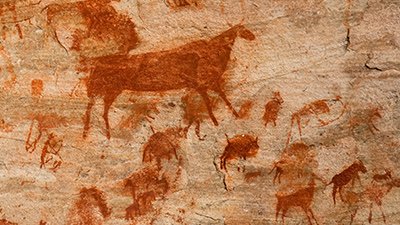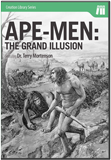Cavemen
Cavemen are viewed as primitive brutes in an evolutionary worldview. But, in a biblical view, they were humans, descended from Adam and Eve. These people lived in the harsh post-Flood world of the Ice Age. They used caves for shelter and made simple, but effective, tools as they travelled and hunted game.
Who Were the Cavemen?
The term caveman is often used as a catchall for peoples who lived in an earlier era in human history—the Ice Age. We’ll focus on five of these groups: Neanderthals, early Homo sapiens (Cro-Magnon man), Homo erectus, Denisovans, and Homo floresiensis.
When Did the Cavemen Live?
The two hundred years or so after Babel (over 300 years after the Flood) was a chaotic transition in world history. The Bible gives us only a brief glimpse into that time and place, but the fossils hint at a grim tale.
Making a Caveman
Artists have displayed their interpretation of hominids and so-called ape men for many years. Whether intentional or not, the final look of the model or drawing is shaped by the biases of the artist and the scientists. In other words, people’s starting points influence their view of the evidence.
Stone Age Brutes or Intelligent People
Scientists sometimes seem surprised to find more evidence that Neanderthals and other historic humans were highly intelligent. Even these “ancient” humans were crafty and knowledgeable.
News About Cavemen
-
Jan. 16, 2023 from Ken Ham Blog
On the walls of certain caves are paintings of animals but next to some of those animals are a series of dots and dashes. What do these markings mean?
Articles About Cavemen
-
April 26, 2020 from Answers Magazine
New DNA technology has allowed scientists to peer into the past by mapping the DNA of so-called cavemen.
-
March 1, 2020 from Answers Magazine
As far as stereotypes go, cavemen make easy targets—especially when transplanted into the twenty-first century.
-
In-Depth ArticleDoes a Paleo-Diet Hold the Evolutionary Key for Good Nutrition?July 3, 2014 from Answers in Depth
Do modern man’s diseases spring from a mismatch between today’s diet and prehistoric anatomy?
-
Answers Magazine Preview: Vol. 7, No. 2April 1, 2012
Cavemen—mysterious denizens of our past—who were they? When did they live, and what happened to them? How different were they, really, from us?
-
April 1, 2012 from Answers Magazine
How do creationists explain the timing and location of early human remains from a biblical perspective?
-
Magazine Department ArticleCaveman ConfusionApril 1, 2012 from Answers Magazine
When you were a child, were you told about cavemen and ape-men and missing links? Of course you were.
-
The Making of a CavemanMarch 27, 2012
The face of Neanderthal on the cover of this issue of Answers was sculpted and designed over a plaster cast of an actual Neanderthal skull.
-
Stone Axes Push Anthropological Views on Humans Back in TimeSept. 10, 2011 from News to Know
Homo erectus tool time tinkers with anthropological thought.
-
On the Skeleton's OrientationApril 9, 2011 from News to Know
In portraying cavemen as dimwits, popular stereotypes often show them as unkempt—and recklessly heterosexual—brutes: claiming brides by clubbing cavewomen over the head and dragging them away. But less frequently portrayed are “homosexual cavemen,” like the one supposedly unearthed in a Prague suburb.
-
Homo Sapiens All the Way BackFeb. 19, 2011 from News to Know
More research supports our view that historic humanity and modern humanity were far more similar than we “modern” humans often think.
-
How Smart Were Cave-Men?Nov. 6, 2010 from News to Know
Our “cave-men” kin: just how smart were they?
-
Cave Dwellers—Are They Ancient?Oct. 24, 2010
In spite of all that archaeologists and anthropologists contend about these early Stone Age cultures and their supposed long ages, it simply cannot be true.
-
Oversimplification of CavemenOct. 23, 2010 from News to Know
The idea of caveman hunter-gatherers is an oversimplification, according to new research into the diet of some of our ancestors.
-
Sharp SurvivormanApril 11, 2009 from News to Know
Stone blades from more than 500,000 years ago: the work of an alleged human ancestor or someone playing Survivorman?
-
New Findings Show That Cavemen Valued SingingJuly 5, 2008
Those oft-portrayed cave-painting “cavemen” were more than mere artists: they were concertmasters skilled in mixing visual art with sound, reports LiveScience.
-
Magazine ArticleKinver CavemanJune 17, 2008 from Answers Magazine
What comes into your mind when you hear the word “cavemen”? We have been so evolutionised that I suspect the majority of people immediately think of hairy, brutish men usually dressed in animal skins.
-
Bone Ice Skates Invented for TravelJan. 12, 2008
Human travelers from five millennia ago raced across icy lakes on skates made from animal bones, reports National Geographic News on research appearing in this month’s Linnean Society of London Biological Journal.
-
Speak Like a CavemanOct. 27, 2007
Despite frequent caricatures of Neanderthals as mentally deficient, grunting cavemen, scientists continue to find evidence that Neanderthals were intelligent beings quite a lot like us.
-
Magazine Department ArticleA Transitional FormOct. 1, 2007 from Answers Magazine
The cavemen seen in car insurance commercials have now transitioned to become the stars of their own TV sitcom.
-
Magazine ArticleThe Amazing Cave People of MaltaDec. 1, 2003, pp. 40–43
‘Do you believe in cavemen?’ Sceptics think ‘gotcha!’ when they ask this question. They might know the Bible says that Adam’s descendants built great cities, but their ‘evidence’ shows otherwise.
-
Walking with Cavemen—Fact or Fiction?June 17, 2003
Building on the popularity of walking with Dinosaurs (1999) and Walking with Beasts (2001), BBC and Discovery Channel have co-produced yet another evolutionary propaganda piece—Walking with Cavemen.
-
Controversy Over “Early Paleolithic” Stone “Tools” in Canada ContinuesAug. 1, 2001
Have you ever wondered about those stone ‘tools’ that evolutionists discover?
-
Magazine ArticleModern ‘Stone Age’ ReconsideredSept. 1, 1993, pp. 51–52
Evolutionists have had to reconsider the history of some tribes which use ‘Stone Age’ technology and live by ‘primitive’ hunting and gathering.
Recommended Resources

Answers in Genesis is an apologetics ministry, dedicated to helping Christians defend their faith and proclaim the good news of Jesus Christ.
- Customer Service 800.778.3390
- © 2024 Answers in Genesis







